Carbon Reduction and Pollutant Abatement by a Bio–Ecological Combined Process for Rural Sewage
Abstract
1. Introduction
2. Material and Methods
2.1. Experimental Device
2.2. Operational Condition
2.3. Monitoring and Data Acquisition
3. Results and Discussion
3.1. Water Quality Index and Wastewater Treatment Effect
3.1.1. The Removal Effect of Combined Process in Summer
3.1.2. The Removal Effect of Combined Process in Winter
3.2. Analysis of Ecological Unit Treatment Effect
3.2.1. Contribution Rate of Pollutant Removal in Ecological Units
3.2.2. Contribution Rate of Pollutant Removal in Ecological Units
3.3. Analysis of C/N of Sewage
4. Conclusions
Author Contributions
Funding
Institutional Review Board Statement
Informed Consent Statement
Data Availability Statement
Acknowledgments
Conflicts of Interest
References
- Li, X.; Li, Y.; Lv, D.; Li, Y.; Wu, J. Nitrogen and phosphorus removal performance and bacterial communities in a multi–stage surface flow constructed wetland treating rural domestic sewage. Sci. Total Environ. 2020, 709, 136235. [Google Scholar] [CrossRef] [PubMed]
- Shen, Z.X. Study on bio-ecological combination treatment of rural domestic sewage. China Resour. Compr. Util. 2021, 39, 201–204, (with English abstract). [Google Scholar] [CrossRef]
- Feng, H.; Hu, L.; Mahmood, Q.; Qiu, C.; Fang, C.; Shen, D. Anaerobic domestic wastewater treatment with bamboo carrier anaerobic baffled reactor. Int. Biodeterior. Biodegrad. 2008, 63, 232–238. [Google Scholar] [CrossRef]
- Liu, J.; Liu, X.; Gao, L.; Xu, S.; Chen, X.; Tian, H.; Kang, X. Performance and microbial community of a novel combined anaerobic bioreactor integrating anaerobic baffling and anaerobic filtration process for low–strength rural wastewater treatment. Environ. Sci. Pollut. Res. 2020, 27, 18743–18756. [Google Scholar] [CrossRef]
- Zhang, J.W.; Ruan, A.D. Research progress on subsurface flow constructed wetland for nitrogen removal. Environ. Sci. Technol. 2017, 30, 72–75, (with English abstract). [Google Scholar] [CrossRef]
- Wu, J. Research on bio-ecological combination treatment of rural sewage. Inn. Mong. Environ. Sci. 2020, 32, 48–49, (with English abstract). [Google Scholar] [CrossRef]
- Zhang, W.; Xu, J.; Li, X.D. Mechanism, application status and research progress of stabilization pond for treatment of wastewater. Ecol. Environ. Sci. 2014, 23, 1396–1401, (with English abstract). [Google Scholar] [CrossRef]
- Huang, J.; Wang, S.H.; Yan, L.; Zhong, Q.S. Plant photosynthesis and its influence on removal efficiencies in constructed wetlands. Ecol. Eng. 2010, 36, 1037–1043. [Google Scholar] [CrossRef]
- Xu, Z.F.; Li, J.C.; Mo, D.Q.; Que, G.L.; Li, W.W.; Sun, X.; Su, C.L.; Huang, L.F. Nitrogen and phosphorus removal from rural domestic wastewater in combined process. J. Guilin Univ. Technol. 2011, 31, 252–257, (with English abstract). [Google Scholar] [CrossRef]
- Cheng, G.; Li, H.; Wu, Q.; Han, B.; Huang, F.; Zhang, W. Current situation, problems and countermeasures of sewage treatment of Guangxi regional rural environment improvement. Chin. J. Environ. Eng. 2015, 9, 5427–5431, (with English abstract). [Google Scholar]
- Manz, W.; Wagner, M.; Amann, R.; Schleifer, K.H. In situ characterization of the microbial consortia active in two wastewater treatment plants. Water Res. 1994, 28, 1715–1723. [Google Scholar] [CrossRef]
- Zhang, T.; Shao, M.F.; Ye, L. 454 Pyrosequencing reveals bacterial diversity of activated sludge from 14 sewage treatment plants. ISME J. 2012, 6, 1137–1147. [Google Scholar] [CrossRef] [PubMed]
- Ding, X.; Jing, R.; Huang, Y.; Chen, B.; Ma, F. Bacterial structure and diversity of rhizosphere and bulk soil of robinia pseudoacacia forests in yellow river delta. Acta. Pedol. Sin. 2017, 54, 1293–1302. [Google Scholar]
- Eichorst, S.A.; Trojan, D.; Roux, S.; Herbold, C.; Rattei, T.; Woebken, D. Genomic insights into the Acidobacteria reveal strategies for their success in terrestrial environments. Environ. Microbiol. 2018, 20, 1041–1063. [Google Scholar] [CrossRef]
- Hug, L.A.; Castelle, C.J.; Wrighton, K.C.; Thomas, B.C.; Sharon, I.; Frischkorn, K.R.; Williams, K.H.; Tringe, S.G.; Banfield, J.F. Community genomic analyses constrain the distribution of metabolic traits across the Chloroflexi phylum and indicate roles in sediment carbon cycling. Microbiome 2013, 1, 22. [Google Scholar] [CrossRef]
- Chen, D.; Wang, H.; Ji, B.; Yang, K.; Wei, L.; Jiang, Y. A high–throughput sequencing study of bacterial communities in an autohydrogenotrophic denitrifying bio–ceramsite reactor. Process Biochem. 2015, 50, 1904–1910. [Google Scholar] [CrossRef]
- Schreier, H.J.; Mirzoyan, N.; Saito, K. Microbial diversity of biological filters in recirculating aquaculture systems. Curr. Opin. Biotechnol. 2010, 21, 318–325. [Google Scholar] [CrossRef]
- Klatt, C.G.; Liu, Z.; Ludwig, M.; Kühl, M.; Jensen, S.I.; Bryant, D.A.; Ward, D.M. Temporal metatranscriptomic patterning in phototrophic Chloroflexi inhabiting a microbial mat in a geothermal spring. ISME J. 2013, 7, 1775–1789. [Google Scholar] [CrossRef]
- Lee, S.H.; Ka, J.O.; Cho, J.C. Members of the phylum Acidobacteria are dominant and metabolically active in rhizosphere soil. FEMS Microbiol. Lett. 2008, 285, 263–269. [Google Scholar] [CrossRef]
- Fang, Y.H.; Peng, J.; Song, Y.; Zhang, P.; Shi, G. High throughput sequencing analysis of microbial communities in different plant rhizosphere in subsurface–flow constructed wetland. Acta. Sci. Circumstantiae 2018, 38, 911–918, (with English abstract). [Google Scholar] [CrossRef]
- Thomas, F.; Hehemann, J.H.; Rebuffet, E.; Czjzek, M.; Michel, G. Environmental and gut bacteroidetes:the food connection. Front. Microbiol. 2011, 2, 93. [Google Scholar] [CrossRef] [PubMed]
- Liu, H.M. Experiment Reseach on Low C/N Ratio Municipal Wastewater Treatment by UCT Process. Master’s Thesis, Jilin University, Changchun, China, 2010. (with English abstract). [Google Scholar]
- Chen, J.Y.; Zhang, Z.; Li, Y.; Mao, B.; Chen, Y. Comprehensive regulation technology for enhancing nitrogen removal from low-carbon wastewater in reversed A2/O process. China Water Wastewater 2010, 26, 32–36, (with English abstract). [Google Scholar] [CrossRef]
- Zhang, M.; Song, X.L.; Huang, Q.T. Research on the sludge micro–oxygen hydrolysis fermentation liquid as the carbon source for the treatment of urban sewage with low C/N ratio. Ind. Water Treat. 2018, 38, 61–65, (with English abstract). [Google Scholar]
- Yuan, Y.; Liu, J.J.; Peng, Y.Z. Enhancement of nitrogen and phosphorus removal municipal waste water by sludge anaerobic fermentation products. J. Harbin Inst. Technol. 2019, 51, 14–19, (with English abstract). [Google Scholar] [CrossRef]
- Yao, C.; Yue, J.X. Enhanced nitrogen and phosphorus removal of low carbon wastewater with sludge anaerobic fermentation liquid. Environ. Sci. Technol. 2016, 39, 150–155, (with English abstract). [Google Scholar] [CrossRef]
- Xiao, L.; He, F.; Liang, X.; Xu, D.; Zhou, Q.; Wu, Z. Impact of solid carbon sources supplement amount on performance of wastewater treatment effect in vertical–flow constructed wetland. Chin. J. Environ. Eng. 2013, 7, 2074–2080, (with English abstract). [Google Scholar]
- Zhao, L.F.; Zhu, W.; Gao, Q. Improving nitrogen removal of constructed wetlands by supplying plant carbon. J. PLA Univ. Sci. Technol. (Nat. Sci. Ed.) 2009, 10, 644–649, (with English abstract). [Google Scholar] [CrossRef]
- Zhang, X.; Liu, J.; Xu, B.; Wang, Q.; Cheng, X. Effect of adding ecological plant carbon sources on nitrogen and phosphorus removal in constructed wetland. Saf. Environ. Eng. 2022, 29, 199–204, (with English abstract). [Google Scholar] [CrossRef]

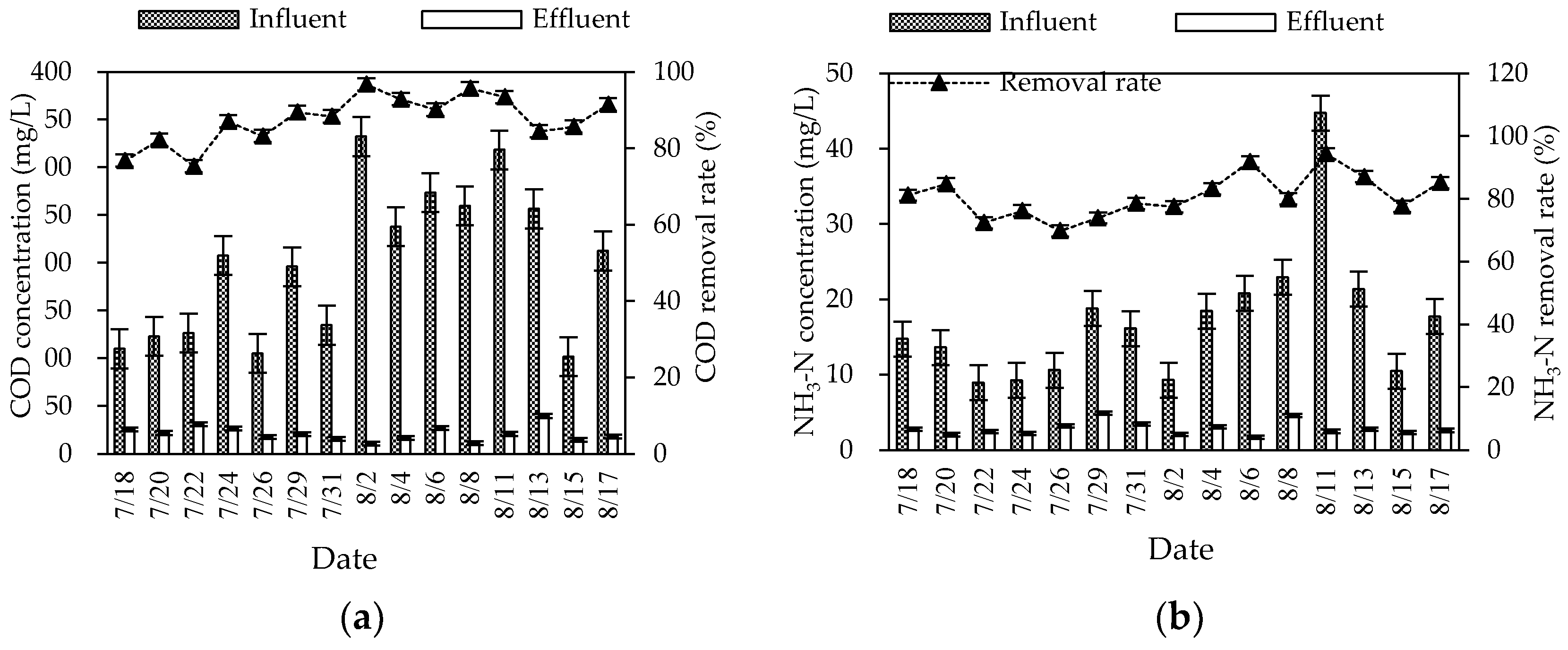
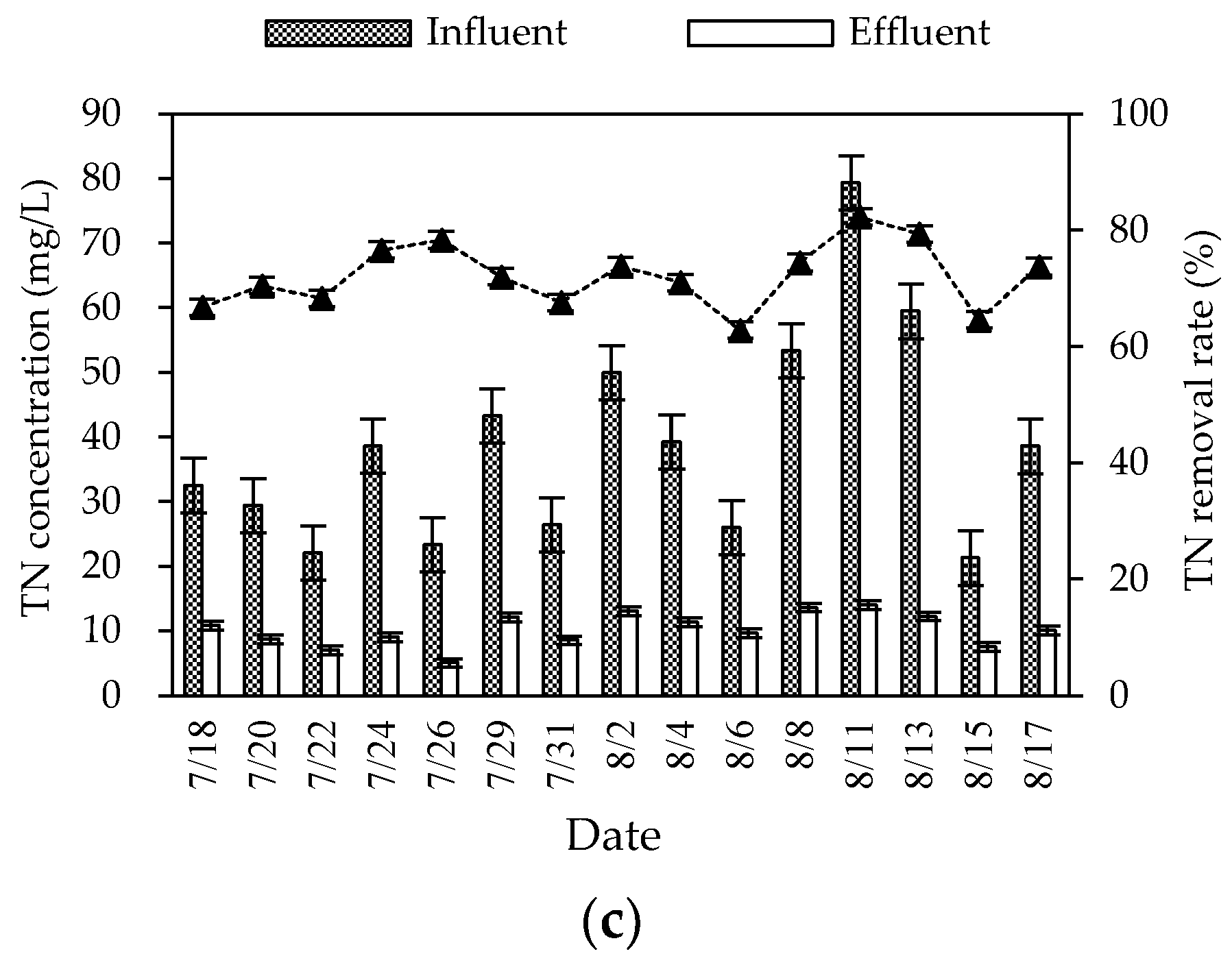
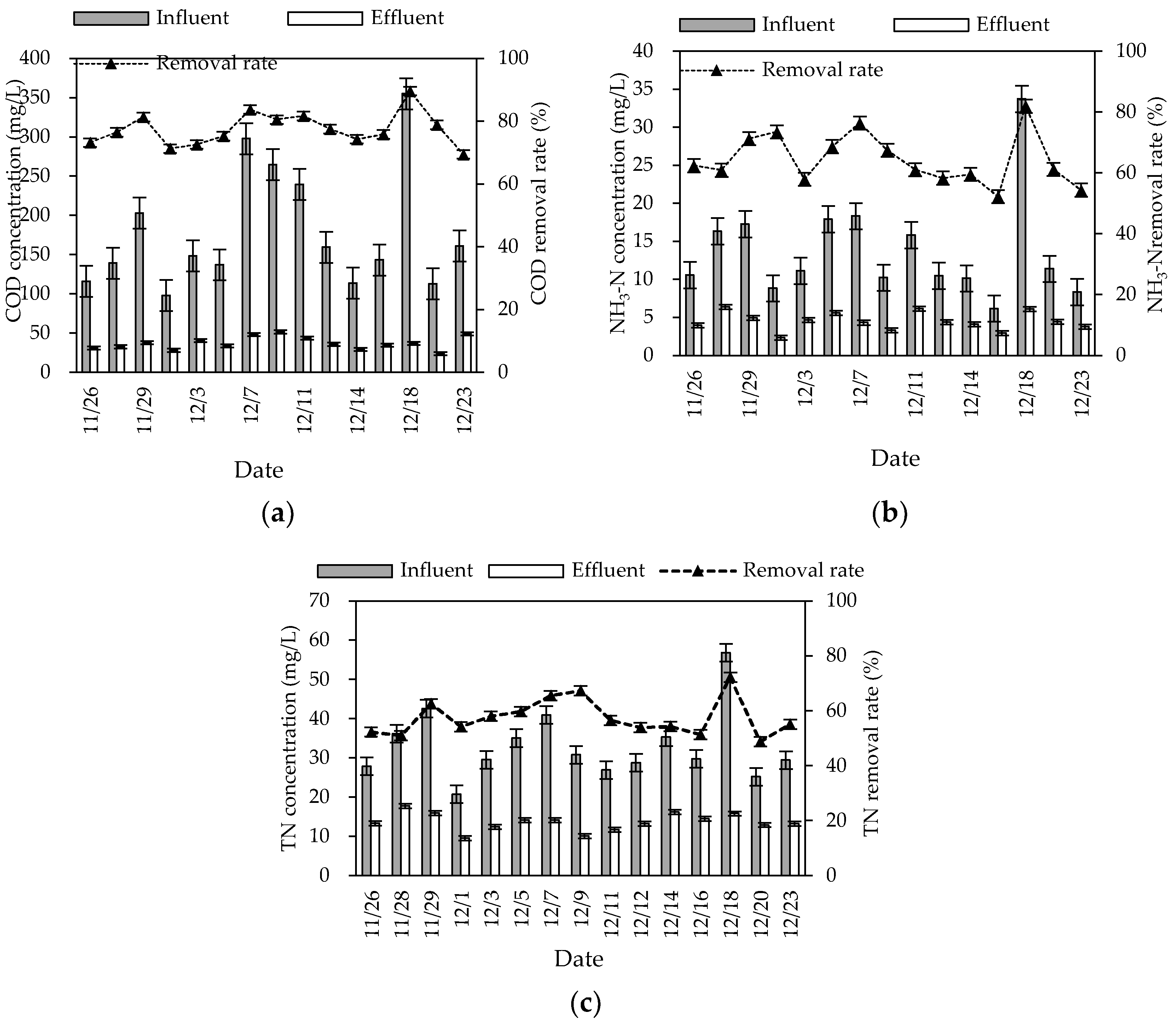
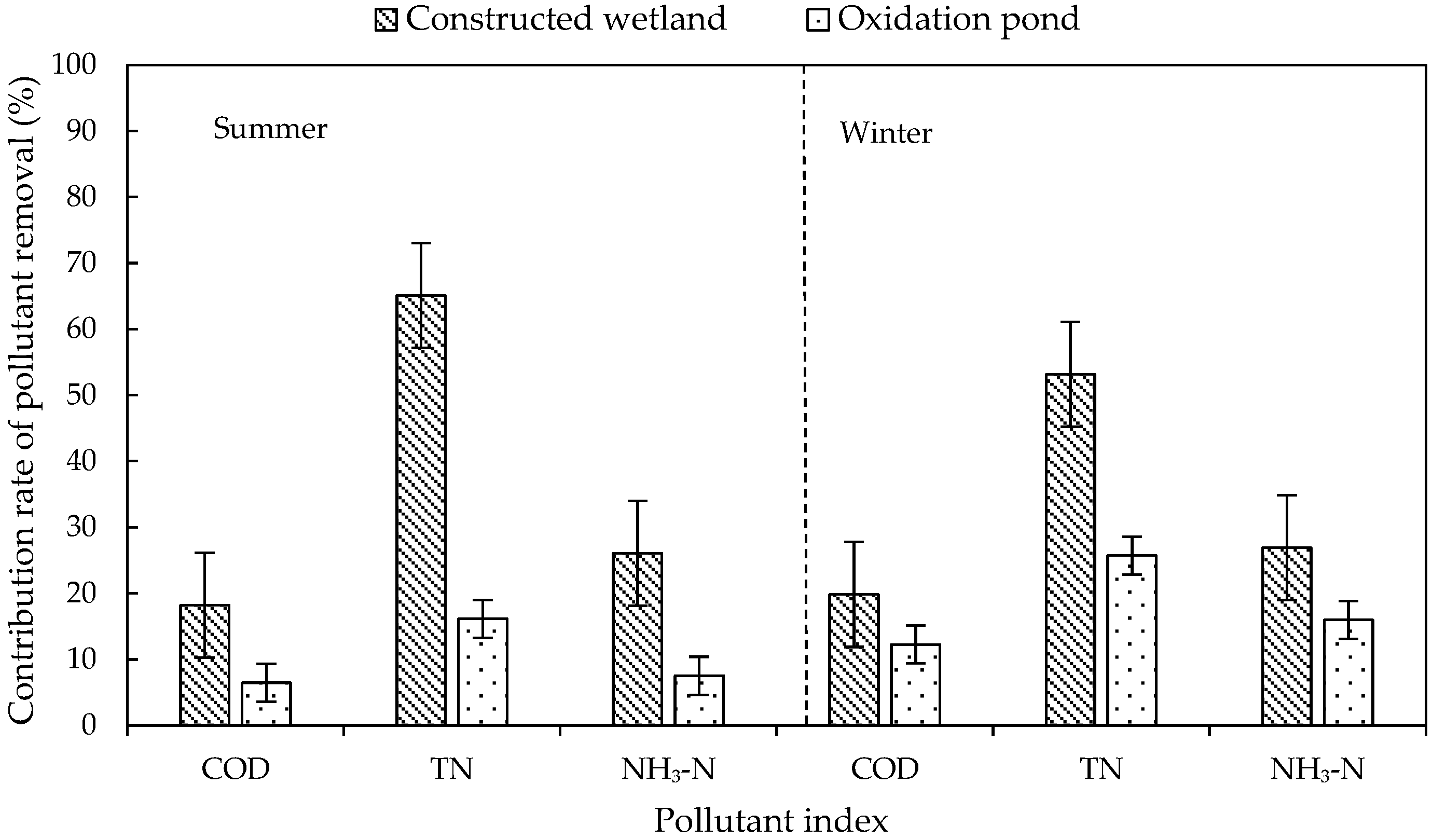
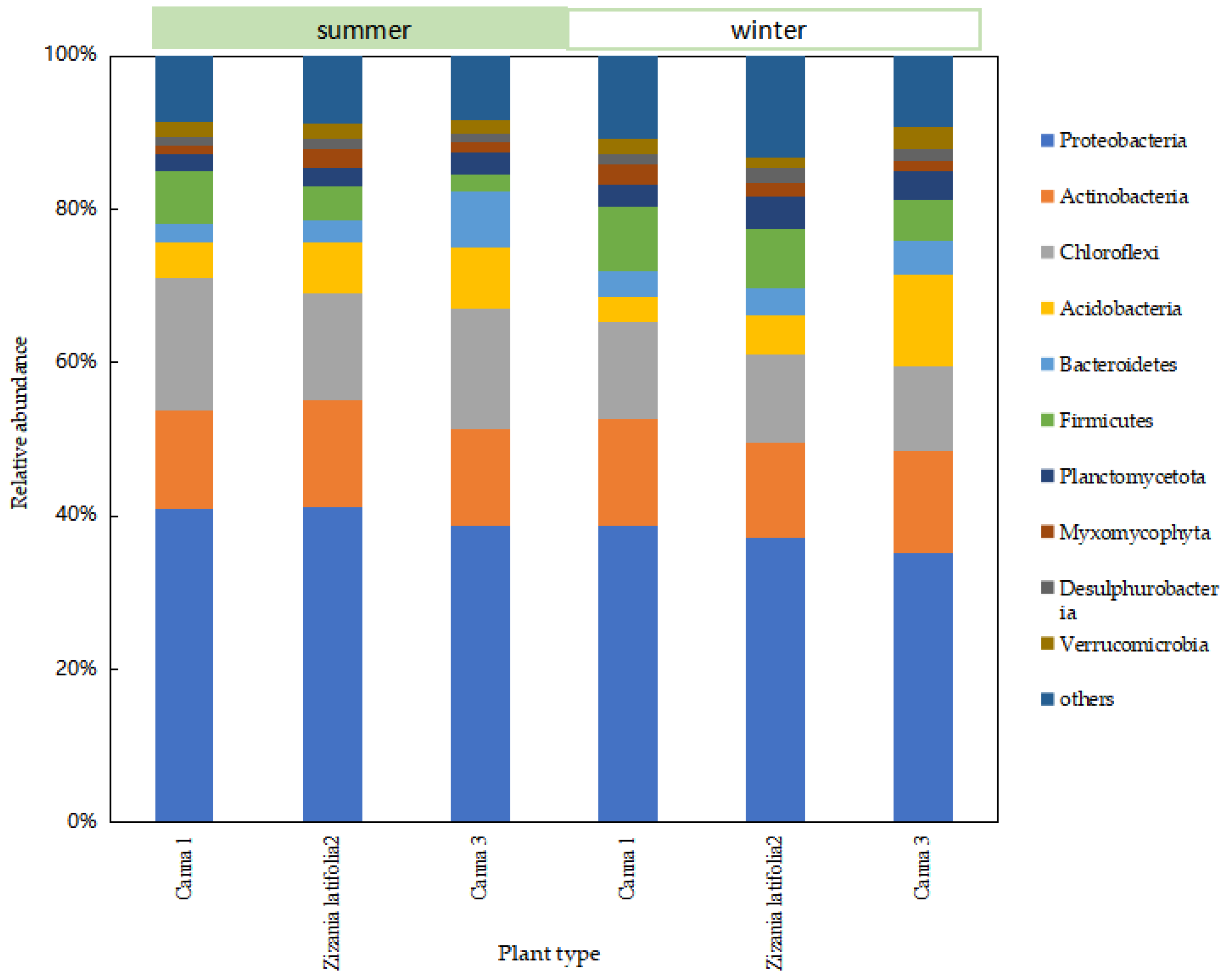

| Item | ρ(COD) | ρ(NH3–N) | ρ(TN) |
|---|---|---|---|
| Measured value in summer | 101.83–332.30 | 8.94–44.75 | 21.28–79.38 |
| Average value in summer | 199.79 | 17.19 | 38.86 |
| Measured value in winter | 98.01–355.12 | 6.17–33.72 | 20.72–56.80 |
| Average value in winter | 179.28 | 13.77 | 33.04 |
| Parameter | Anaerobic Pool | Biological Filter | Constructed Wetland | Oxidation Pond | |
|---|---|---|---|---|---|
| Hydraulic load m3/(m2·d) | Summer | 1.26 | 1.25 | 0.08 | 0.07 |
| Winter | 1.05 | 1.04 | 0.07 | 0.06 | |
| HRT (d) | Summer | 0.875 | 0.875 | 11 | 11 |
| Winter | 1.042 | 1 | 13 | 113 | |
| Monitoring Project | Monitoring Method | Instrument |
|---|---|---|
| Chemical oxygen demand (COD) | Potassium dichromate method/ Fast catalytic oxidation method | COD determination instrument Model CTL-12A |
| DO | Oxygen dissolved method | Portable dissolved oxygen meter Model WTWoxi330 in German |
| Total nitrogen (TN) | K2S2O8 oxidization–ultraviolet spectrometry | Ultraviolet spectrophotometer Model 752 |
| Ammonia nitrogen (NH3–N) | Nessler’s reagent spectrophotometry | Spectrophotometer Model 721 |
| pH | pH meter method | pH meter |
| temperature (T) | Thermometer method | Thermometer |
Disclaimer/Publisher’s Note: The statements, opinions and data contained in all publications are solely those of the individual author(s) and contributor(s) and not of MDPI and/or the editor(s). MDPI and/or the editor(s) disclaim responsibility for any injury to people or property resulting from any ideas, methods, instructions or products referred to in the content. |
© 2023 by the authors. Licensee MDPI, Basel, Switzerland. This article is an open access article distributed under the terms and conditions of the Creative Commons Attribution (CC BY) license (https://creativecommons.org/licenses/by/4.0/).
Share and Cite
Jin, Q.; Chen, L.; Yang, S.; Zhu, C.; Li, J.; Chen, J.; Li, W.; Peng, X. Carbon Reduction and Pollutant Abatement by a Bio–Ecological Combined Process for Rural Sewage. Int. J. Environ. Res. Public Health 2023, 20, 1643. https://doi.org/10.3390/ijerph20021643
Jin Q, Chen L, Yang S, Zhu C, Li J, Chen J, Li W, Peng X. Carbon Reduction and Pollutant Abatement by a Bio–Ecological Combined Process for Rural Sewage. International Journal of Environmental Research and Public Health. 2023; 20(2):1643. https://doi.org/10.3390/ijerph20021643
Chicago/Turabian StyleJin, Qiu, Liangang Chen, Shengyun Yang, Chaochao Zhu, Jingang Li, Jing Chen, Wei Li, and Xinxin Peng. 2023. "Carbon Reduction and Pollutant Abatement by a Bio–Ecological Combined Process for Rural Sewage" International Journal of Environmental Research and Public Health 20, no. 2: 1643. https://doi.org/10.3390/ijerph20021643
APA StyleJin, Q., Chen, L., Yang, S., Zhu, C., Li, J., Chen, J., Li, W., & Peng, X. (2023). Carbon Reduction and Pollutant Abatement by a Bio–Ecological Combined Process for Rural Sewage. International Journal of Environmental Research and Public Health, 20(2), 1643. https://doi.org/10.3390/ijerph20021643







